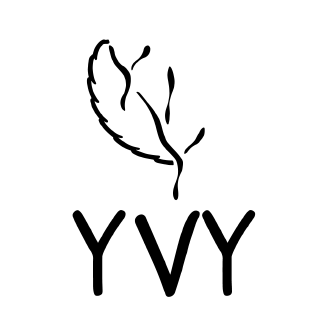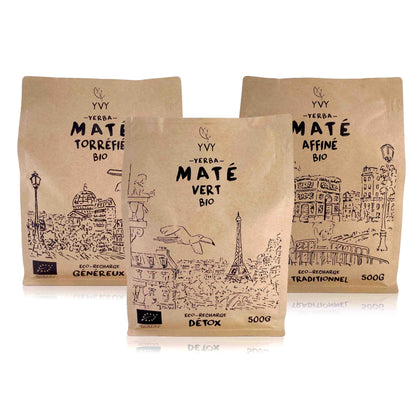

Mate is gradually starting to gain recognition.
Once consumed exclusively in the central region of South America, the opening up to the global market and new consumer expectations has completely changed the production processes of mate for some farmers.
But then, why were the production methods changed?
How might these new cultivation and production methods change the flavor of maté?
Summary
The traditional production of yerba mate

Modern monoculture harvesting of yerba mate
Previously, yerba mate was cultivated entirely wild for direct consumption by the Guarani people. The yerba mate tree was so widespread that there wasn't enough demand to justify cultivating it.
It was only after the arrival of the Jesuits in Guarani territory, and the discovery of this plant, that a form of agriculture first emerged. This plant then spread beyond borders to become today an emblem of South American culture .
Over the years, the mate industry has significantly refocused on central South America, primarily affecting Argentina, Paraguay, Bolivia, Uruguay, and southern Brazil .
The growing demand for yerba mate has led to rather intensive agriculture driven by cultivation methods optimized for productivity.
Fertilizers and insecticides have also enabled increasingly strong production, making it possible to meet demand at an ever more competitive price.
New production methods

The agroforestry cultivation method
Yerba mate is gaining increasing popularity due to its unique flavor and numerous health benefits . A significant rise in consumption has been observed worldwide , and this trend is expected to continue and even accelerate in the coming years.
This new demand has led to many changes in the cultivation of yerba mate . Today, some growers focus their production on 100% international export, but to do so, they have had to adapt to consumption criteria, particularly in Europe.
The transformation of cultures initially involved organic farming .
Moreover, in order to stand out, these farmers have refocused on the plant and sought to improve the quality of the leaves at the expense of productivity.
So, what improves the quality of the mate? Does it influence the taste of the final infusion?
The influences of the quality of the yerba mate

The search for quality influences in yerba mate
Mate, like all plants, draws its resources primarily from the soil . Besides soil quality, plant growth depends on numerous factors, which themselves are more or less specific to the species.
Factors that influence the development of a plant include, for example, orientation, altitude, light, humidity, branch pruning technique, etc.
These factors, when identified, allow the plant to be cultivated optimally by maximizing its qualities .
Mate is no exception to these rules. Once the main quality factors of mate were identified , a real expertise emerged, and Grand Cru mates were notably created.
What are the quality factors of yerba mate? What methods allow us to obtain a Grand Cru yerba mate?
The Terroir

The influence of terroir on maté
Terroir is often discussed in relation to wine or coffee, but regardless of the plant, terroir will greatly influence the growth and flavor of the fruits or leaves.
As we saw earlier, a plant is subject to many factors that influence its development. In particular, the terroir, which encompasses several sub-factors such as: topography, climate, soil, drainage, and even geology.
Some growers analyze soil quality beforehand in order to take advantage of the best plots to obtain the best final quality of mate leaves.
Different flavor complexities will be obtained depending on the terroir, including floral , vegetal and even fruity notes.
We have carefully selected the plot of land that produces our fabulous grand cru mate every year.
Sowing

The careful selection of seedlings
Yerba mate has developed different characteristics over the years depending on its region. The final flavor of the mate is greatly influenced by the type of seed used in its cultivation.
The different sowings result in visible distinctions in stems, leaf sizes, leaf color, and even the wax of the mate leaves.
The more waxy and shiny the yerba mate leaves become, the more bitter the infusion will be . This is what is called "native" yerba.
Brazilian seedlings, for example, have very intense green leaves with a slightly "waxy" appearance.
This is the type of yerba mate that our partner producers cultivate.
The different farming methods

Harvesting yerba mate in agroforestry
Yerba mate can be cultivated in different ways. The cultivation method will also influence the final flavor of the infusion .
The first type of cultivation is traditional monoculture production. This is the type of cultivation with the highest productivity and the fastest financial return.
The overproduction is due to overexposure to the sun. Indeed, these crops are most often located in clearings, unlike the agroforestry model.
The second type of mate cultivation is agroforestry production.
This farming method relies on natural cultivation , without fertilizers , and above all , at the heart of biodiversity . This agricultural model is less productive due to the significant shade provided and a much lower number of plants compared to monoculture.
Mate leaves are harvested when fully mature , approximately every 24 months, compared to 4 to 6 months for monoculture. Because the leaves develop more slowly, the concentration of natural sugars and aroma is higher, giving them an incomparable taste.
The average yield of a monoculture, compared to an agroforestry model, is about 10 times higher , partly explaining the price differences between mate grown in a “traditional” way or in agroforestry.
Drying
The drying process drastically influences the flavor of the yerba mate . In fact, there are two types of drying, which we will detail here.
- Slow drying with smoke

Barbecue-style smoke drying
This is the most common type of drying. It involves placing the yerba mate leaves on a mat above a furnace. The hot smoke then passes between the leaves and dries them slowly (approximately 4 hours). The smoke is therefore much more noticeable in terms of flavor.
Several studies suggest that this drying process is not ideal for health. Indeed, during this process, PAHs (polycyclic aromatic hydrocarbons), a known carcinogen, are absorbed by the yerba mate leaves.
We do not recommend consuming smoke-dried mate.
- Rapid drying with smoke
This type of drying is quite common in Brazil. The yerba mate leaves pass through rotating tubes heated to 130°C by a dry wood fire . After only 30 minutes, the yerba mate leaves are ready to consume.
This type of drying has the advantage of being very fast , so the smoke will have little impact on the final flavor of the mate, provided that the wood used is well dry.
- Slow drying without smoke

Drying yerba mate without smoke
This is the type of drying we use for all our yerba mate. It's a smokeless drying process , posing no health risks. It's an indirect drying method : hot air is conducted through metal tubes, which then dry the leaves by conduction at a constant temperature of 110°C for 3 hours.
The infusion will then have no smoky flavor like that found in smoke-dried yerba mate.
It is a very expensive drying process , which is why it is still not widespread in South America.
All the yerba mate teas we offer are smoke-free dried.
As we have just seen, the flavor of mate is influenced by a large number of factors , making the plant as complex as a coffee, a wine, or even a specialty tea.
The large price disparities per kilo that can be found on the mate market, as with coffee in particular, are influenced by the quality of work and know-how behind each infusion.
We have decided to offer for the moment two different qualities of mate with a range of Grands Crus organic mates which expresses all the aromatic and taste potential of mate, still very (too) little known today by amateurs, as well as a range of classic organic mates .
Latest articles

Mistakes to avoid when preparing your mate

What is the composition of yerba mate? Caffeine, antioxidants, and vitamins

Barbacuá mate: a dangerous traditional drying method?







